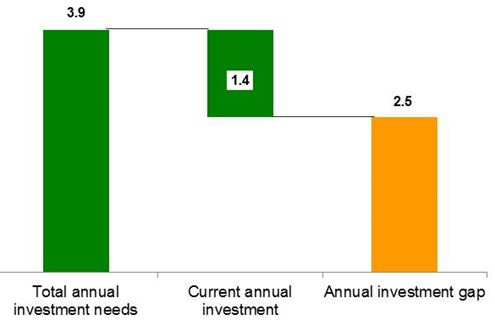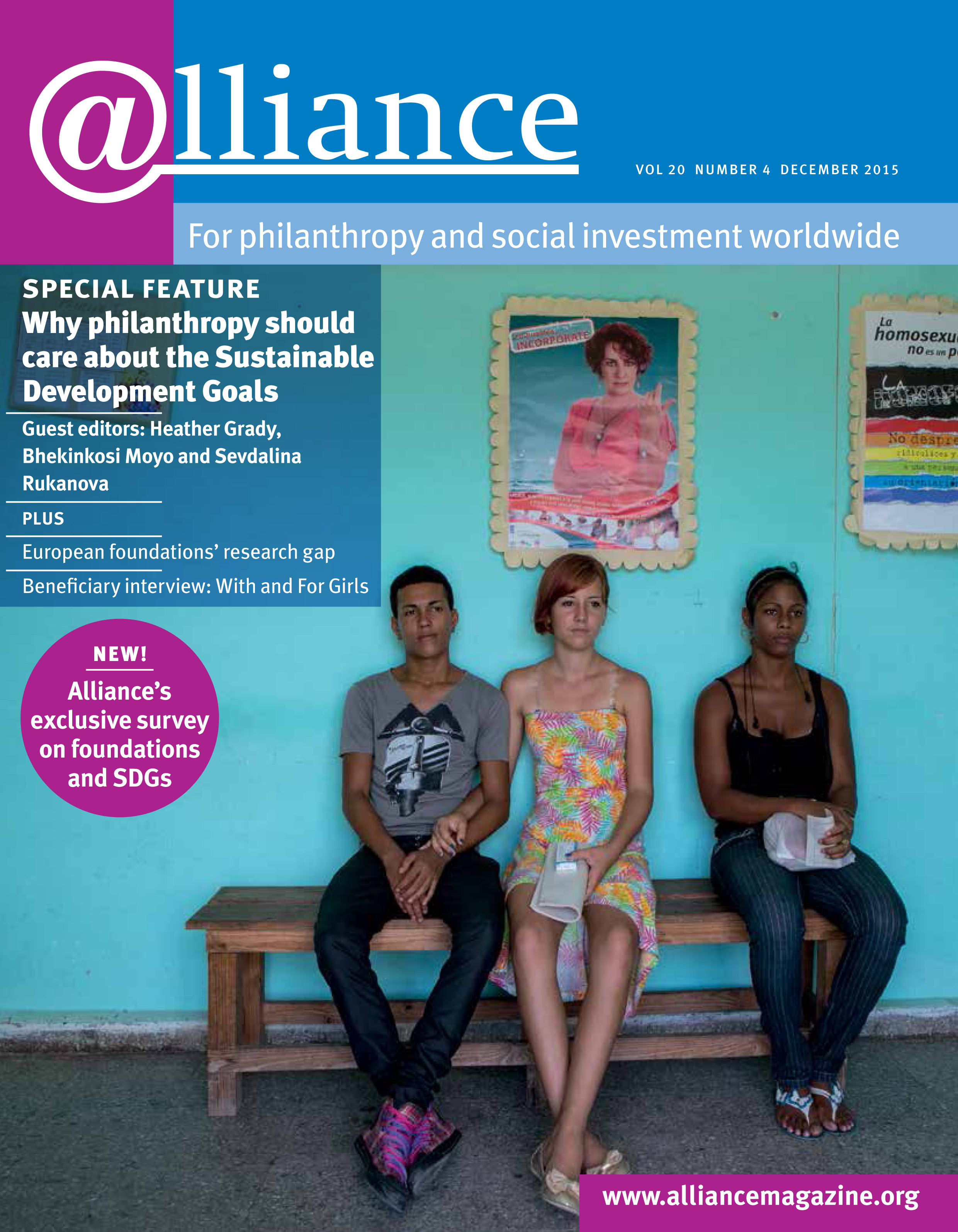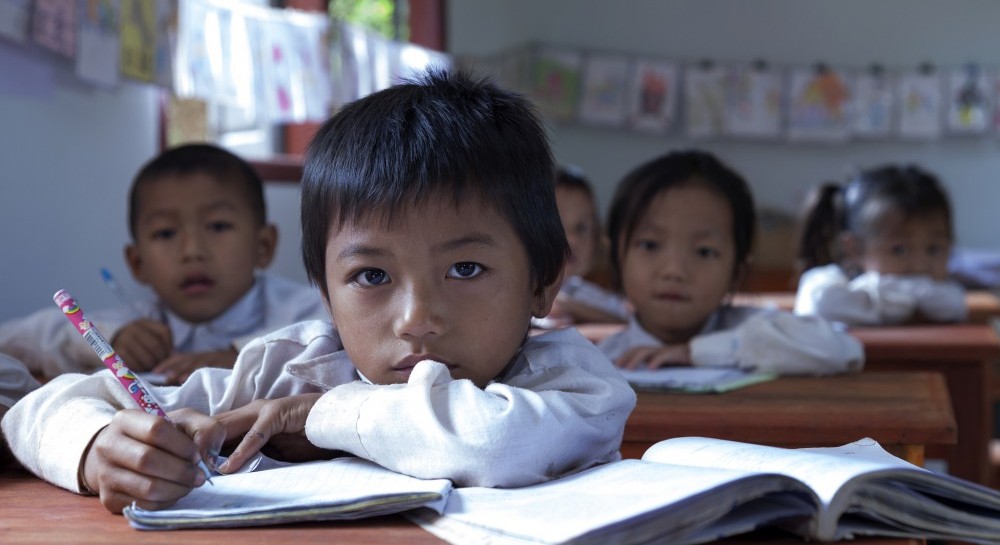The Sustainable Development Goals will require governments to rethink how they collect and allocate funds, and how private investors and businesses must reorient their practices towards positive social and environmental impacts.
Over the past two years, while governments negotiated the Post-2015 Agenda and the SDGs, a separate stream of talks focused on how to pay for them, culminating with the Third International Conference on Finance for Development (FFD3) in Addis Ababa in July, where delegates agreed to an Outcome Document that defines financial priorities and resource mobilization methods.
Billions to trillions gap
Some criticism has highlighted the absence of committed funds to back up these extremely ambitious goals. Estimates of the cost to achieve the 17 SDGs hover around $3.5 trillion to $5 trillion annually in developing countries alone[1], outpacing official development assistance (ODA) at around $227.9 billion a year by 2030, according to UNDP estimates. Financial flows from philanthropy, remittances, South-South flows, and other official assistance do not come close to making up the difference.
So the goals could never be fully funded even if all ODA and philanthropic resources are combined. A phrase coined to represent the gap is ‘moving from billions to trillions’, in thinking about how to raise money to support the goals.
‘Estimates of the cost to achieve the 17 SDGs hover around $3.5 trillion to $5 trillion annually in developing countries alone.’
Political discussions always emphasize the importance of ODA commitments, with States urged to maintain the target of about 0.7 per cent of gross national income, and the need to use aid especially for the least developed countries – those with the greatest needs and least ability to mobilize domestic resources.
The FFD Outcome Document also suggests ODA be used to catalyse commitments from other public and private sources. Sources of capital include improved tax collection, building essential public services that save remedial funds otherwise needed later – the way vaccination prevents many illnesses – and unlocking additional finance through blended or pooled financing and risk mitigation. The Outcome Document also emphasizes greater South-South cooperation.
‘These goals, for the first time, focus the world on the fact that human development, wellbeing and environmental sustainability cannot be the domain solely of government departments and private donations.’
Some commentators say the gap between needs and existing resources calls the whole framing of the SDG endeavour into question. But others – my fellow optimists and I – see it differently. These goals, for the first time, focus the world on the fact that human development, wellbeing and environmental sustainability cannot be the domain solely of government departments and private donations.
Change financial priorities to support goals
Can we agree that aims like access to education for all, decent work for all, healthcare for all, and avoiding climate and environmental catastrophes are achievable within 15 years if resources are used and shared differently? If so, then we have an opportunity, even a mandate, to create local, national and global action plans that put us on the path to actually achieving the SDGs.
ODA will likely provide only a small portion of the $3.5 trillion to $5 trillion needed. The rest must come, not only from philanthropy, but mainly from national financing frameworks that raise funds differently, and the enormous sums of private capital not currently serving a social purpose.
Some big‑ticket financing, like closing the sustainable and resilient infrastructure gap – in areas like transport, energy, and water and sanitation for all – will be facilitated through inter-governmental organizations like the new Asian Infrastructure Investment Bank, the Global Infrastructure Hub, and the Africa50 Infrastructure Fund.
Alternative financing measures were also included as options to mobilize domestic public resources. For example, governments in Addis committed to reduce inefficient fossil fuel subsidies. They also agreed to redouble efforts to substantially reduce illicit financial flows by 2030 – eventually to eliminate them, combating tax evasion and corruption through strengthened national regulation and international cooperation.
Moreover, changing how domestic and international private business and finance is conducted is considered crucial to achieving the SDGs. The FFD Outcome Document commits governments to:
‘Develop policies and, where appropriate, strengthen regulatory frameworks to better align private sector incentives with public goals, including incentivizing the private sector to adopt sustainable practices, and foster long‑term quality investment.’
‘We encourage impact investing, which combines a return on investment with non-financial impacts. We will promote sustainable corporate practices, including integrating environmental, social and governance factors into company reporting as appropriate, with countries deciding on the appropriate balance of voluntary and mandatory rules.’

The chart shows the gap between the expected annual cost of SDG implementation and current annual investment, in trillions of dollars, based on low estimates.
Changing business practice requires both incentives and pressure on many fronts, including from consumers and the public. As many foundations and civil society organizations have noted, this is not simply placing basic services into the private sector, which can have negative impacts on access by poor communities. Rather it is doing business differently, for example, taking into account all the stakeholders of a company – from local communities to workers in supply chains, not just the shareholders. It means reorienting investment funds, from pensions to foundation endowments. Some business leaders have seen the imperative and the opportunities. The We Mean Business Coalition and the World Business Council on Sustainable Development, for example, have pledged to support the Sustainable Development Goals.
Where does this leave philanthropy?
Our resources may be modest compared to the total needs, but they are an important and sustainable part of the whole, and one that is finally being officially recognized.
The FFD Outcome Document, importantly, included guidance on our sector:
‘We welcome the rapid growth of philanthropic giving and the significant financial and non‑financial contribution philanthropists have made towards achieving our common goals. We recognize philanthropic donors’ flexibility and capacity for innovation and taking risks and their ability to leverage additional funds through multi-stakeholder partnerships.
‘Our resources may be modest compared to the total needs, but they are an important and sustainable part of the whole, and one that is finally being officially recognized.’
‘We encourage others to join those who already contribute. We welcome efforts to increase cooperation between philanthropic actors, governments and other development stakeholders. We call for increased transparency and accountability in philanthropy. We encourage philanthropic donors to give due consideration to local circumstances and align with national policies and priorities. We also encourage philanthropic donors to consider managing their endowments through impact investment, which considers both profit and non-financial impacts in its investment criteria.’
‘Philanthropy may be a bit late to the table, but there is growing interest in how our resources, approaches and talents can contribute to achieving the SDGs.’
Philanthropic funding runs from patient capital that enables long-term social movements, to risk capital that supports pilots that, if successful, can be scaled up through larger donor or government resources, or through policy change. Some foundations support civil society’s monitoring and advocacy.
The funds are generally in the form of grants, but increasingly will come from the corpus of foundation endowments that flow into socially responsible investment funds and impact investing.
Where once philanthropy was perceived as a financially conservative sector, more and more philanthropists and foundations – often led by ‘next-genners’ – are ready to deploy their resources through debt and equity investing in social enterprises and not-for-profits.
There are at least 200,000 foundations in Europe and the US alone, with a growing number in countries around the world. Their efforts may be uncoordinated and disparate, but they hold a wealth of knowledge and experience in the goal themes. These resources reside in grantees, grantmakers and operational foundations. The SDG Philanthropy Platform, mentioned elsewhere in this issue, is helping to track how philanthropy is contributing to SDGs both by goal area and by geography.
As the FFD Outcome Document stated:
‘We will all be held accountable by future generations for the success and delivery of commitments we make today. As the SDGs are launched on 1 January 2016, it will be a rallying point for every sector to rethink the part its resources play in promoting sustainable development and human wellbeing.’
Heather Grady is a vice president of Rockefeller Philanthropy Advisors. Email hgrady@rockpa.org
For more discussion on the SDG debate, listen to our Alliance Audio podcast.
Footnotes
- ^ UNCTAD, World Investment Report 2014, p140








Comments (0)